Life with the Lenovo Yoga 2 Pro
by Brett Howse on July 30, 2014 2:00 PM EST- Posted in
- Notebooks
- Lenovo
- Windows 8.1
- Yoga
Wi-Fi Performance
Most Ultrabooks are at the point where they are too thin to even include a standard Ethernet port, and the Yoga 2 Pro is no exception. As a consumer device, this is generally not an issue as most laptops are used over Wi-Fi anyway, so a high quality wireless card is important. Unfortunately the Intel Wireless-N 7260 (an M.2 card which integrates Bluetooth 4.0) has some major features missing for a $1099 laptop. The lack of 802.11ac support might be forgivable, since 802.11ac is fairly new, but the fact that this card has only 2x2 TX/RX stream support at 2.4GHz can be a deal breaker for many people. It’s somewhat sad that in 2014, a premium device can be sold without 5GHz Wi-Fi.
I understand there are margins to maintain, but for a device that lives entirely on Wi-Fi, a small amount spent here would help a lot. On Amazon.com, the price difference between the Intel Wireless-N 7260 ($10) and the Dual-Band Intel Wireless-N 7260, which supports 5GHz, is $10, and moving up to the AC version is only another $10. It would be unlikely Lenovo is paying that much per card. On a $1000 laptop, this isn't acceptable Wi-Fi.
Let’s take a look at the Wi-Fi performance:
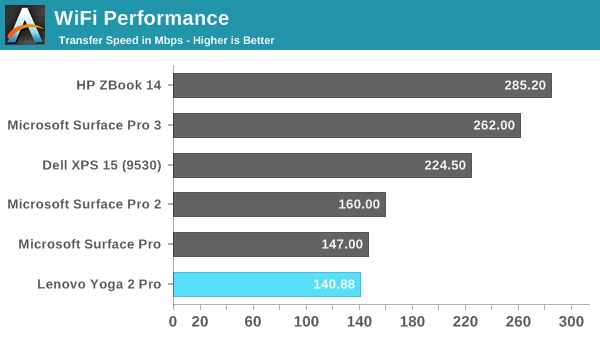
When running these performance tests, I could not get the device to connect at anything higher than 144 Mbps, even on a router with just this device connected. Troubleshooting that led me to a newer driver version for the Intel wireless card (dated June 2014) and once installed I was immediately able to connect at the maximum of 300 Mbps. Keep in mind however that interference on 2.4GHz is pretty high for most areas, so this is very much a best-case scenario.
Even with a 300Mbps connection, maximum transfer speed was not great with the Yoga 2 Pro only achieving 141 Mbps. This is a real disappointment on a device with a price tag of around the thousand dollar mark. A 5GHz connection should be the minimum acceptable level here.
While doing research on the wireless card choice, I found several people who recently purchased a Yoga 2 Pro which they claim comes with the Intel Wireless AC 7260 card which would improve this result quite a bit. I've reached out to Lenovo to verify this information and will post an update if they confirm it.
Tablet Performance
Due to the dual nature of the Yoga 2 Pro, we can also compare it to other two-in-one devices and tablet performance. Being an i5-4200U, it should easily outperform Bay Trail equipped two-in-one devices and be more in line with the Surface Pro offerings. Compared to ARM based tablets, it will be significantly faster.

Sunspider is a light workload that tests single-threaded performance. The Core i5 in the Yoga 2 Pro comes out on top.
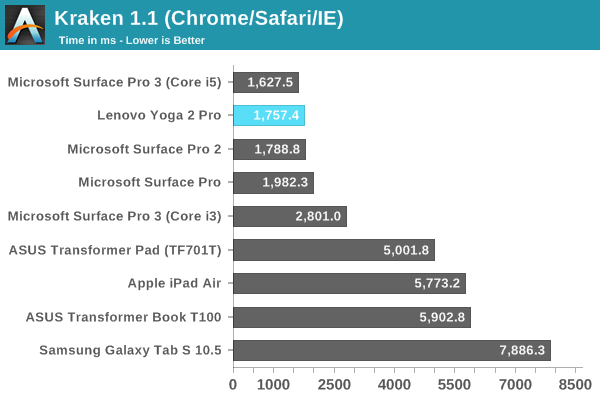
Kraken is similar to Sunspider, with the Core series pulling an even greater advantage over Bay Trail and ARM based tablets.
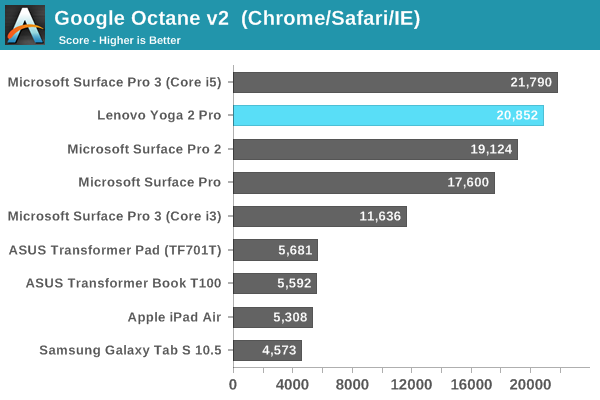

The more complex the javascript load gets, the further the Core series pull away from everything else. The Core i5 pulls a pretty substantial lead over the i3-4020Y of the Surface Pro 3 due to the lack of Turbo Boost on the i3 model, even though the base clock speeds are similar.
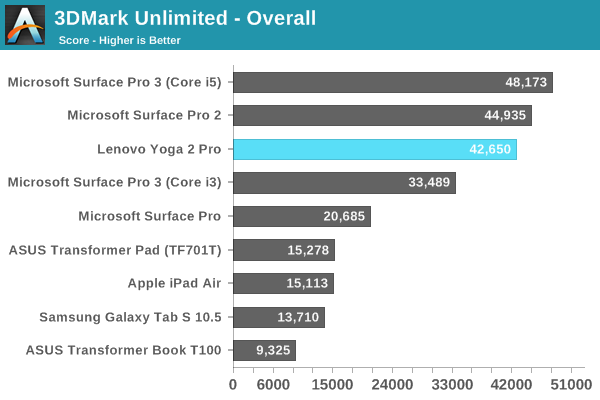
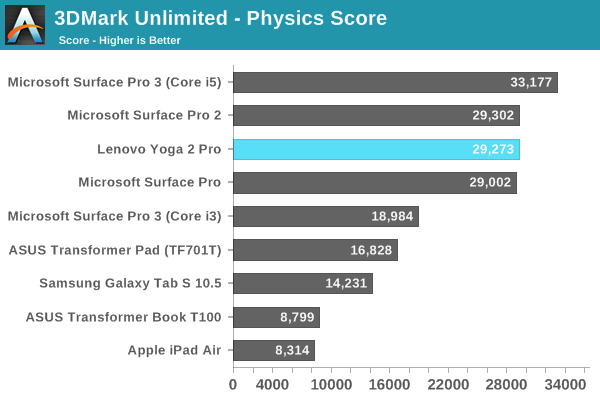
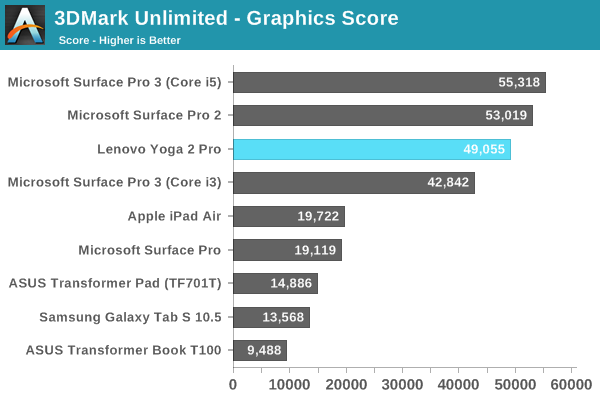
Graphics performance, while not spectacular as a laptop, is very good compared to tablet form factor devices.
As an outright tablet, the Yoga 2 Pro is plenty fast, but being based on a laptop it isn’t designed to imitate a pure tablet experience. For instance, it does not feature support for Connected Standby, so the standard sleep mode for this is to use S3 sleep instead, so wake from sleep can take several seconds.
These comparisons to tablets show that the Core series has a substantial performance lead over the competition, however it has to be noted that the ARM and Bay Trail competitors are in a completely different power envelope. These benchmarks show why you may want to use a device like the Yoga 2 Pro with touch. The performance is still quite a leap from the true tablet devices out there, making tasks like web browsing a better experience.










103 Comments
View All Comments
SanX - Friday, August 8, 2014 - link
What is actually very BAD and no one noticed- Crazy 97C temperature of processor cores. Intel must speed up its 14nm technology
- Because matrix is pentile its PPI=195 or may be a bit better due to RGBW. This makes this screen actually even worse then in Microsoft Surface 3 PPI=216. You can see all its gargantuan pixels on both. How tech people are sooooooo damn fooled by the fake 3200 numbers? Large tablet screens ***must be 4K***
Rdmkr - Sunday, August 10, 2014 - link
your PPI math is off; the number of subpixels matches that of a 225 PPI 13.3 inch non-pentile screen. I thought pentile was a disaster until I learned that the human eye almost completely ignores color information in registering pixel-level detail. The wikipedia page for "Chrominance" has a good picture to demonstrate this, as does the one for the "YCbCr" color space. Another piece of evidence towards this is that blue-ray content has heavily undersampled color information and hardly anyone ever notices or mentions that it is less than "true" 1080p.mitchellvii - Tuesday, September 9, 2014 - link
Sorry dude but I've owned both the Surface Pro and the Y2P and I'm here to tell you, the Surface Pro comes nowhere close to the clarity of this screen. You honestly have no idea what you are talking about.mitchellvii - Tuesday, September 9, 2014 - link
97C? Lol, really? My Y2P i7 rarely even gets warm. I could bake bread on my Surface Pro.Bateluer - Sunday, August 10, 2014 - link
I almost bought this same model a few weeks back, but ended up going for the older 11s model instead. The Yoga 2s were definitely nice, but that un-upgradeable RAM is a real buzz kill.medi02 - Monday, August 11, 2014 - link
I wish they'd do it with one of AMD's APUs. The one with discrete GPU is way to expensive and Intel HD is a no thanks, not to mention the higher price.petwho - Monday, August 11, 2014 - link
I bought a Lenovo laptop last year. But its performance was so slow that I decided never come back with this brand.venkman - Monday, August 18, 2014 - link
Good write up. I bought a Y2P in November 2013 and pretty much agree with everything you said here. Thankfully the yellow issue was resolved with a firmware update because I was about to take the dang thing back just for that. Other than that, the WiFi is a joke and a lot of people on the lenovo and notebookreview forums have taken to manually upgrading the wifi cards themselves. The screen resolution is nice but completely unnecessary considering the impact it has on battery life. Not many programs fully support it anyways. I feel like Lenovo got some kind of crazy deal from their supplier on these 1800p screens that actually saved them money by going this route instead of a 1080p screen. Other than that, I love my Y2P and I fly with it regularly. It is a dream in cramped economy with tablet and tent mode. Flight attendants ask my GF to put her Macbook Air (which I believe weighs less) away when the door closes but never bother me with my Y2P in tablet mode.mitchellvii - Tuesday, September 9, 2014 - link
If you want deeper blacks, just turn down the gamma. Everyone knows that. Geesh. Blacks on my unit with gamma at .5 are as inky as on a super amoled display.mitchellvii - Tuesday, September 9, 2014 - link
You blame the Y2P for having poor black levels when the fact is YOU are the one with NO clue how too adjust black levels on a PC. It's called "Gamma" and it's in the HD Control Panel. Honestly, if you are going to be a reviewer, please get some rudimentary computer knowledge.